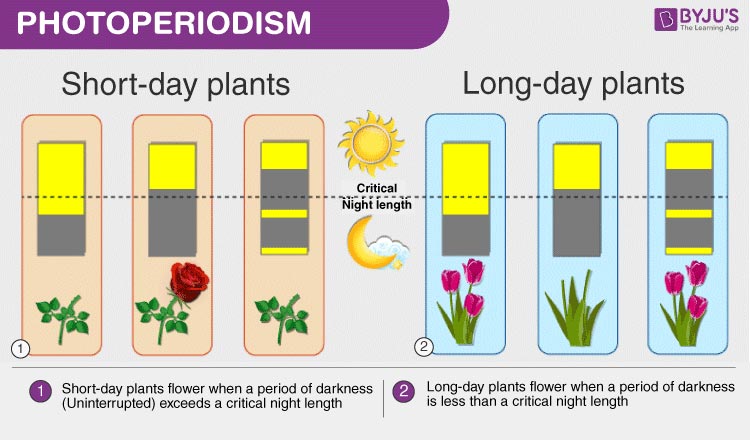As we all know, different plants have a variety of physiological, developmental and growth responses towards the light, dark, seasons, exposure to low temperature. These changes are also seen in animals and birds.
Let’s try and understand this concept -Photoperiodism in more detail.
Table of Contents
“Photoperiodism may be defined as the response of plants and animals to the length of the day and the night.”
What Is Photoperiodism?
The relative length of day and night is known as photoperiod. Some plants need to be exposed to sunlight for a particular duration of time to induce flowering. This is the reason behind the seasonal blooming of flowers.
This type of natural phenomenon was first discovered and identified by Charles Darwin and his son Francis in the year 1880.
Also Read: Photomorphogenesis

Photoperiodism- Short Day and Long Day Plants
Photoperiodism In Plants
Most angiosperms (flowering plants) use photoperiodism to determine when to flower. To do that they use one of the photoreceptor proteins present in their bodies, such as cryptochrome or phytochrome.
There is a well defined critical duration. This critical duration is different for different plants. Based on this duration, plants can be categorized into three categories:
Long Day Plants
The plants which require more exposure to light are called long-day plants (LDP). For example – Radish, Spinach, Sugar beet etc.
Short Day Plants
Those plants which require less exposure to light are called short-day plants (SDP).For example- Sunflower, Rice, Soybeans, Tobacco, etc.
Day Neutral Plants
Plants in which the flowering occur irrespective of the day lengths are called day-neutral plants (DNP). Some of the day-neutral plants examples are rose, tomatoes, cucumber, etc. Day-neutral plants flower after attaining a certain developmental stage. The flowering is not based on photoperiodism.
Also Read: Photoperiodism, Vernalization and Seed dormancy
Scientists worldwide use photoperiodism for the classification and location analysis of plants. Long day plants, such as chrysanthemums, hibiscus, petunias, and spinach, can never be found where the length of the day is less. Similarly, short-day plants, such as cotton, spinach, rice, and sugarcane are not typically found where the length of the night is less.
Research and investigation have shown that darkness is more important to short-day plants than light day plants. That is to say that long day plants are more likely to flower even if their period in the light is interrupted by darkness for a certain amount of time than short-day plants if their period in darkness is interrupted by sudden bright light.
Day-neutral plants, on the other hand, do not let light or darkness affect the timing of their flowering. Instead, their flowering is based on other factors such as age or some external stimulus. rose, tomato, and cucumber may be cited as examples of day-neutral plants.
Photoperiodism in Animals
Many animals, especially those living at higher latitudes, use photoperiodism to adjust themselves to the seasonally behavioural and developmental strategies. The phenomenon is not as drastic and evident in animals as much as it is in plants but certain animals do respond to the time of the year for certain behaviours.
For example, seasonal breeding in many animals, singing of birds during longer days, the diapause in the insects, etc.
Also Read: Photoperiodism and Vernalization
This was a brief overview of photoperiodism in plants and animals.
To know more about what is photoperiodism, photoperiodism in plants and animals, keep visiting BYJU’S website or download BYJU’S app for further reference.

Comments